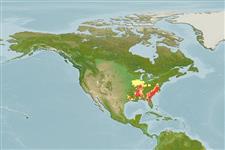Classification / Names
Common names | Synonyms | Catalog of Fishes (gen., sp.) | ITIS | CoL | WoRMS | Cloffa
Actinopterygii (ray-finned fishes) >
Perciformes (Perch-likes) >
Centrarchidae (Sunfishes)
Etymology: Centrarchus: Greek, kentron = sting + Greek, archos = anus (Ref. 45335); macropterus: From the Greek words kentron=spine, archos=anus (referring to the development of the anal spines); macropterus (Greek)=long fin (Ref. 79012).
Environment / Climate / Range
Ecology
Freshwater; demersal; pH range: 6.5 - 7.5; dH range: 10 - 15. Temperate; 12°C - 22°C (Ref. 1672), preferred ?; 42°N - 29°N
North America: occurs only in the USA from Potomac River drainage in Maryland to central Florida and west to Trinity River in Texas; north in Former Mississippi Embayment to southern Illinois and southern Indiana.
Size / Weight / Age
Maturity: Lm ? range ? - ? cm
Max length : 29.2 cm TL male/unsexed; (Ref. 40637); common length : 13.0 cm TL male/unsexed; (Ref. 12193); max. published weight: 560.00 g (Ref. 4699); max. reported age: 6 years (Ref. 72462)
Occur in swamps, vegetated lakes, ponds, sloughs and backwaters and pools of creeks and small rivers, usually over mud (Ref. 5723, 10294). Invertivore: feed mainly on Hemiptera and Corixidae (Ref. 79012).
Life cycle and mating behavior
Maturity | Reproduction | Spawning | Eggs | Fecundity | Larvae
Produces a minimum of 200 eggs.
Page, L.M. and B.M. Burr, 1991. A field guide to freshwater fishes of North America north of Mexico. Houghton Mifflin Company, Boston. 432 p. (Ref. 5723)
IUCN Red List Status (Ref. 115185)
CITES (Ref. 94142)
Not Evaluated
Threat to humans
Harmless
Human uses
Aquarium: commercial
More information
ReferencesAquacultureAquaculture profileStrainsGeneticsAllele frequenciesHeritabilityDiseasesProcessingMass conversion
Tools
Special reports
Download XML
Internet sources
